- Inicio
- Acerca de nosotros
- Industria
- Servicios
- Leyendo
- Contáctenos
Mercado de la trombosis venosa profunda: Análisis actual y pronóstico (2024-2032)
Énfasis en la clase de fármacos (anticoagulantes, heparina y otros); Tratamiento (cirugía, fármacos y otros); Usuario final (hospitales, clínicas especializadas, instituciones académicas y CRO, y otros); y Región/País
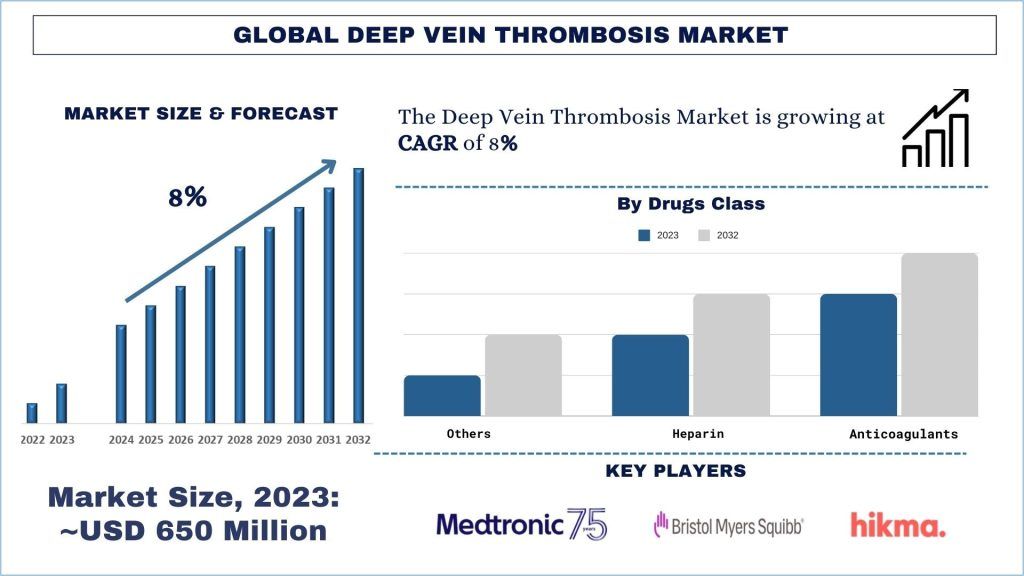 Tamaño y Pronóstico del Mercado Global de Trombosis Venosa Profunda
Tamaño y Pronóstico del Mercado Global de Trombosis Venosa Profunda
El mercado global de trombosis venosa profunda se valoró en ~USD 650 millones en 2023 y se espera que crezca a una fuerte CAGR de alrededor del ~8% durante el período de pronóstico (2024-2032). Debido a los avances en las herramientas de imagenología y diagnóstico que facilitaron la detección más temprana y precisa de la TVP.
Análisis del Mercado Global de Trombosis Venosa Profunda
El tamaño del mercado de trombosis venosa profunda en todo el mundo se está expandiendo debido a varios factores, como el aumento del comportamiento sedentario, como estar sentado o inmóvil durante mucho tiempo, lo que aumenta el riesgo de TVP. Además, el aumento de los procedimientos quirúrgicos, especialmente las cirugías ortopédicas, aumenta la necesidad de profilaxis y tratamiento de la TVP.
Febrero de 2023: Bayer anunció que los primeros pacientes se habían inscrito en los ensayos iniciales de su programa de ensayos clínicos OCEANIC, diseñado para explorar el uso de asundexian (BAY2433334), un inhibidor oral en investigación del Factor XIa (FXIa), en pacientes con fibrilación auricular (FA) y pacientes con un accidente cerebrovascular isquémico no cardioembólico o un ataque isquémico transitorio (AIT) de alto riesgo, un período temporal de síntomas similares a los de un accidente cerebrovascular.
Tendencias del Mercado Global de Trombosis Venosa Profunda
Esta sección analiza las tendencias clave del mercado que están influyendo en los diversos segmentos del mercado global de Trombosis Venosa Profunda, según lo identificado por nuestro equipo de expertos en investigación.
Segmento de Cirugía Transformando la Industria
La categoría de cirugía es un impulsor importante del mercado de Trombosis Venosa Profunda (TVP), particularmente en la región de Asia-Pacífico. Los procedimientos quirúrgicos, especialmente los principales como cirugías ortopédicas, cardíacas y oncológicas, aumentan significativamente el riesgo de desarrollar TVP. Este elevado riesgo exige el uso de medidas profilácticas, incluidas terapias anticoagulantes y dispositivos mecánicos, para prevenir la formación de coágulos de sangre. A medida que el volumen de cirugías continúa aumentando debido a los avances en la tecnología médica, una mayor accesibilidad a la atención quirúrgica y una creciente población de edad avanzada, la demanda de soluciones de prevención y tratamiento de la TVP aumenta correspondientemente. Este aumento en los procedimientos quirúrgicos, junto con protocolos mejorados de atención postoperatoria destinados a mitigar el riesgo de TVP, es un factor clave que impulsa el crecimiento del mercado de TVP en la región.
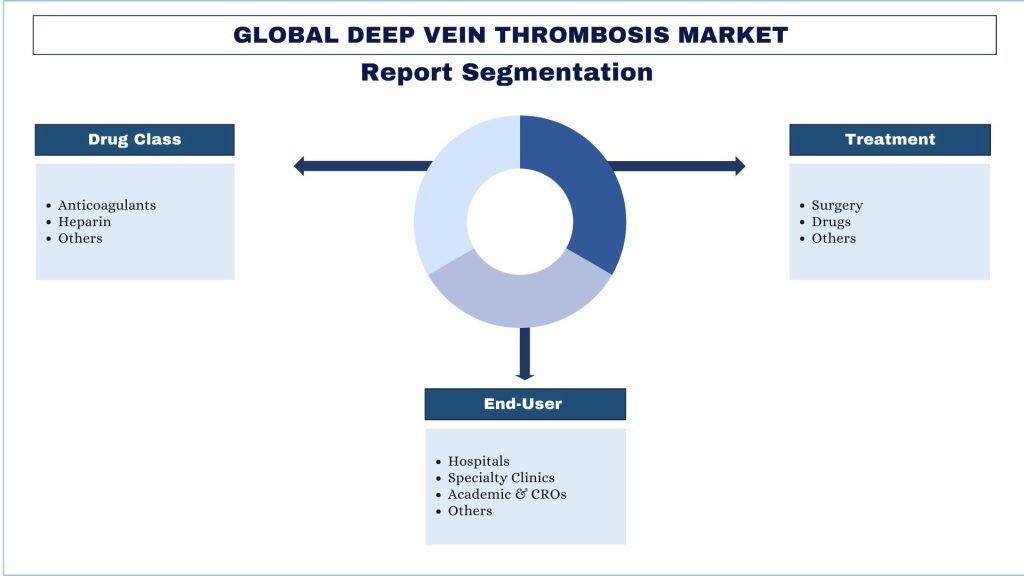
Se espera que Asia-Pacífico crezca a la CAGR más rápida durante el período de pronóstico
El mercado de trombosis venosa profunda (TVP) de Asia-Pacífico está experimentando un crecimiento significativo debido a una mayor conciencia de la afección, el aumento del gasto en atención médica y una creciente población de edad avanzada. Los avances tecnológicos en los métodos de diagnóstico y las opciones de tratamiento, incluidos los nuevos anticoagulantes y los procedimientos mínimamente invasivos, están impulsando la expansión del mercado. Países como China, Japón e India están liderando el desarrollo del mercado, impulsados por la prevalencia de factores de riesgo como estilos de vida sedentarios, obesidad y enfermedades crónicas. Además, las iniciativas gubernamentales para mejorar la infraestructura de atención médica y promover el diagnóstico y el tratamiento tempranos están impulsando aún más el mercado. Como resultado, el mercado de TVP de Asia-Pacífico está preparado para un crecimiento sólido en los próximos años.
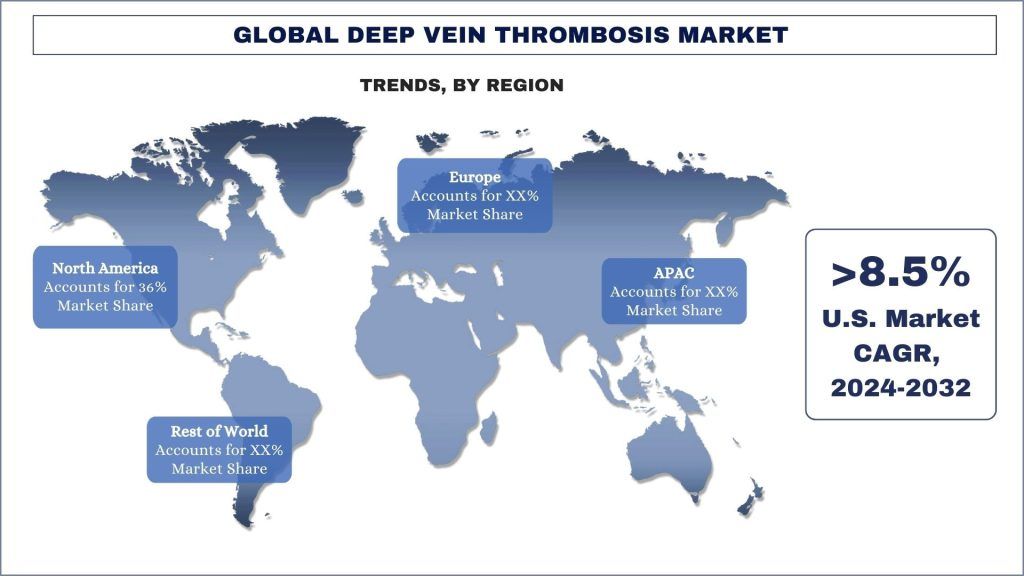
Visión General de la Industria Global de Trombosis Venosa Profunda
El mercado global de trombosis venosa profunda es competitivo, con varios actores del mercado global e internacional. Los actores clave están adoptando diferentes estrategias de crecimiento para mejorar su presencia en el mercado, como asociaciones, acuerdos, colaboraciones, lanzamientos de nuevos tipos, expansiones geográficas y fusiones y adquisiciones. Algunos de los principales actores que operan en el mercado son Medtronic, Aspen Holdings, Novartis AG, Mylan N.V., GLENMARK PHARMACEUTICALS LTD., Hikma Pharmaceuticals PLC, Bristol-Myers Squibb Company, GL Pharma, COBAPHARMA, Boehringer Ingelheim International GmbH
Cobertura del Informe del Mercado Global de Trombosis Venosa Profunda
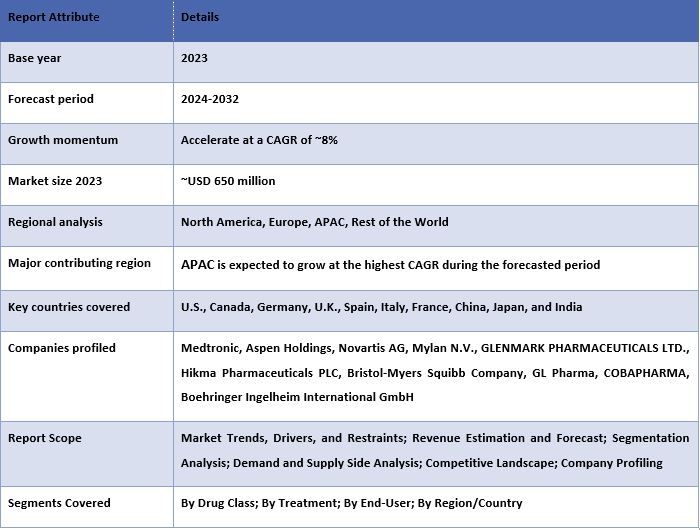
Razones para comprar este informe:
- El estudio incluye el dimensionamiento del mercado y el análisis de pronóstico validados por expertos clave autenticados de la industria.
- El informe presenta una revisión rápida del rendimiento general de la industria de un vistazo.
- El informe cubre un análisis en profundidad de los pares prominentes de la industria con un enfoque principal en las finanzas comerciales clave, las carteras de tipos, las estrategias de expansión y los desarrollos recientes.
- Examen detallado de los impulsores, las restricciones, las tendencias clave y las oportunidades que prevalecen en la industria.
- El estudio cubre de manera integral el mercado en diferentes segmentos.
- Análisis profundo a nivel regional de la industria.
Opciones de Personalización:
El mercado global de trombosis venosa profunda se puede personalizar aún más según los requisitos o cualquier otro segmento de mercado. Además de esto, UMI entiende que puede tener sus propias necesidades comerciales, por lo tanto, no dude en contactarnos para obtener un informe que se adapte completamente a sus requisitos.
Tabla de contenido
Metodología de Investigación para el Análisis del Mercado Global de Trombosis Venosa Profunda (2024-2032)
El análisis del mercado histórico, la estimación del mercado actual y la previsión del mercado futuro del mercado global de trombosis venosa profunda fueron los tres pasos principales que se llevaron a cabo para crear y analizar la adopción de la Trombosis Venosa Profunda global en las principales regiones. Se llevó a cabo una exhaustiva investigación secundaria para recopilar las cifras históricas del mercado y estimar el tamaño actual del mercado. En segundo lugar, para validar estos conocimientos, se tomaron en consideración numerosos hallazgos y supuestos. Además, también se realizaron exhaustivas entrevistas primarias con expertos de la industria en toda la cadena de valor del mercado global de trombosis venosa profunda. Tras la suposición y validación de las cifras del mercado a través de entrevistas primarias, empleamos un enfoque de arriba hacia abajo/de abajo hacia arriba para pronosticar el tamaño total del mercado. Posteriormente, se adoptaron métodos de desglose del mercado y de triangulación de datos para estimar y analizar el tamaño del mercado de los segmentos y subsegmentos a los que pertenece la industria. La metodología detallada se explica a continuación:
Análisis del Tamaño Histórico del Mercado
Paso 1: Estudio Profundo de Fuentes Secundarias:
Se llevó a cabo un estudio secundario detallado para obtener el tamaño histórico del mercado global de trombosis venosa profunda a través de fuentes internas de la empresa, como informes anuales y estados financieros, presentaciones de rendimiento, comunicados de prensa, etc., y fuentes externas, como revistas, noticias y artículos, publicaciones gubernamentales, publicaciones de la competencia, informes del sector, bases de datos de terceros y otras publicaciones creíbles.
Paso 2: Segmentación del Mercado:
Después de obtener el tamaño histórico del mercado global de trombosis venosa profunda, realizamos un análisis secundario detallado para recopilar información histórica del mercado y la cuota de mercado para diferentes segmentos y subsegmentos de las principales regiones. Los principales segmentos incluidos en el informe son la clase de fármaco, el tratamiento, el usuario final y las regiones. Además, se llevaron a cabo análisis a nivel de país para evaluar la adopción general de los modelos de prueba en esa región.
Paso 3: Análisis de Factores:
Después de adquirir el tamaño histórico del mercado de diferentes segmentos y subsegmentos, realizamos un análisis de factores detallado para estimar el tamaño actual del mercado global de trombosis venosa profunda. Además, realizamos un análisis de factores utilizando variables dependientes e independientes como la clase de fármaco, el tratamiento, el usuario final y las regiones del mercado global de trombosis venosa profunda. Se llevó a cabo un análisis exhaustivo de los escenarios de oferta y demanda teniendo en cuenta las principales asociaciones, fusiones y adquisiciones, la expansión empresarial y los lanzamientos de productos en el sector del mercado global de trombosis venosa profunda en todo el mundo.
Estimación y Previsión del Tamaño Actual del Mercado
Tamaño Actual del Mercado: Basándonos en la información práctica de los 3 pasos anteriores, llegamos al tamaño actual del mercado, los actores clave en el mercado global de trombosis venosa profunda y las cuotas de mercado de los segmentos. Todos los porcentajes de participación requeridos y los desgloses del mercado se determinaron utilizando el enfoque secundario mencionado anteriormente y se verificaron a través de entrevistas primarias.
Estimación y Previsión: Para la estimación y previsión del mercado, se asignaron ponderaciones a varios factores, incluidos los impulsores y las tendencias, las restricciones y las oportunidades disponibles para las partes interesadas. Después de analizar estos factores, se aplicaron técnicas de previsión relevantes, es decir, el enfoque de arriba hacia abajo/de abajo hacia arriba, para llegar a la previsión del mercado para 2032 para diferentes segmentos y subsegmentos en los principales mercados a nivel mundial. La metodología de investigación adoptada para estimar el tamaño del mercado abarca:
- El tamaño del mercado de la industria, en términos de ingresos (USD) y la tasa de adopción del mercado global de trombosis venosa profunda en los principales mercados a nivel nacional
- Todos los porcentajes de participación, divisiones y desgloses de los segmentos y subsegmentos del mercado
- Actores clave en el mercado global de trombosis venosa profunda en términos de tipos ofrecidos. Además, las estrategias de crecimiento adoptadas por estos actores para competir en el mercado de rápido crecimiento.
Validación del Tamaño y la Cuota del Mercado
Investigación Primaria: Se realizaron entrevistas en profundidad con los Líderes de Opinión Clave (KOL), incluidos los Ejecutivos de Alto Nivel (CXO/VP, Jefe de Ventas, Jefe de Marketing, Jefe de Operaciones, Jefe Regional, Jefe de País, etc.) en las principales regiones. Los hallazgos de la investigación primaria se resumieron y se realizó un análisis estadístico para probar la hipótesis establecida. Las aportaciones de la investigación primaria se consolidaron con los hallazgos secundarios, convirtiendo así la información en conocimientos prácticos.
División de los Participantes Primarios en Diferentes Regiones
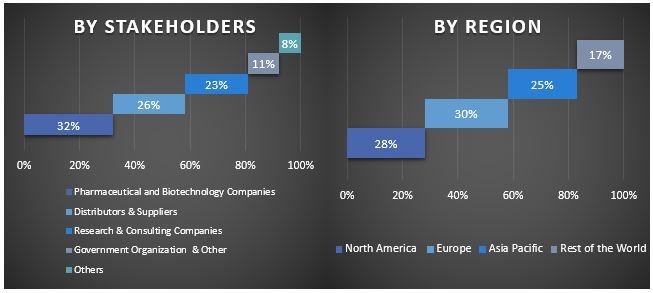
Ingeniería de Mercado
Se empleó la técnica de triangulación de datos para completar la estimación general del mercado y para llegar a cifras estadísticas precisas para cada segmento y subsegmento del mercado global de trombosis venosa profunda. Los datos se dividieron en varios segmentos y subsegmentos después de estudiar varios parámetros y tendencias en la clase de fármaco, el tratamiento, el usuario final y las regiones en el mercado global de trombosis venosa profunda.
El objetivo principal del Estudio del Mercado Global de Trombosis Venosa Profunda
Las tendencias actuales y futuras del mercado global de trombosis venosa profunda se señalaron en el estudio. Los inversores pueden obtener información estratégica para basar su discreción para las inversiones en el análisis cualitativo y cuantitativo realizado en el estudio. Las tendencias actuales y futuras del mercado determinaron el atractivo general del mercado a nivel regional, proporcionando una plataforma para que el participante industrial explote el mercado sin explotar para beneficiarse de una ventaja de ser el primero en actuar. Otros objetivos cuantitativos de los estudios incluyen:
- Analizar el tamaño actual y previsto del mercado global de trombosis venosa profunda en términos de valor (USD). Además, analizar el tamaño actual y previsto del mercado de diferentes segmentos y subsegmentos.
- Los segmentos en el estudio incluyen áreas de la clase de fármaco, el tratamiento, el usuario final y las regiones.
- Definir y analizar el marco regulatorio para la industria.
- Analizar la cadena de valor involucrada con la presencia de varios intermediarios, junto con el análisis de los comportamientos de los clientes y competidores de la industria.
- Analizar el tamaño actual y previsto del mercado global de trombosis venosa profunda para las principales regiones.
- Los principales países de las regiones estudiadas en el informe incluyen Asia Pacífico, Europa, Norteamérica y el resto del mundo
- Perfiles de empresa del mercado global de trombosis venosa profunda y las estrategias de crecimiento que adoptan los actores para mantenerse en el mercado de rápido crecimiento.
- Análisis profundo a nivel regional de la industria
Preguntas frecuentes Preguntas frecuentes
P1: ¿Cuál es el tamaño actual del mercado global de trombosis venosa profunda y su potencial de crecimiento?
P2: ¿Cuáles son los factores impulsores del crecimiento del mercado mundial de trombosis venosa profunda?
P3: ¿Qué segmento tiene la mayor cuota del mercado mundial de trombosis venosa profunda por categoría de clase de fármaco?
P4: ¿Cuáles son las tecnologías emergentes y las tendencias en el mercado global de trombosis venosa profunda?
P5: ¿Qué región dominará el mercado global de trombosis venosa profunda?
Relacionados Informes
Los clientes que compraron este artículo también compraron










